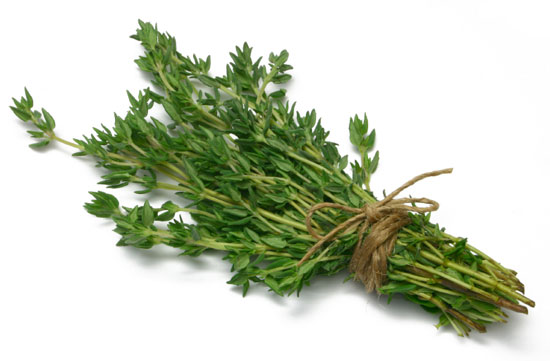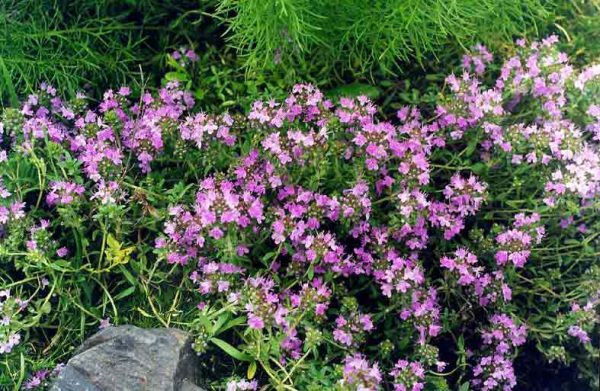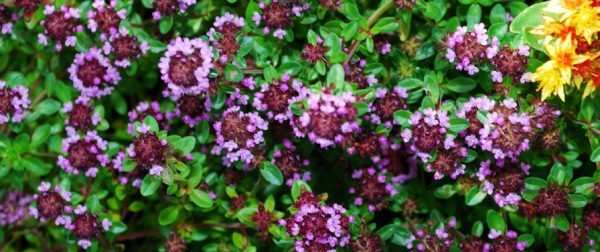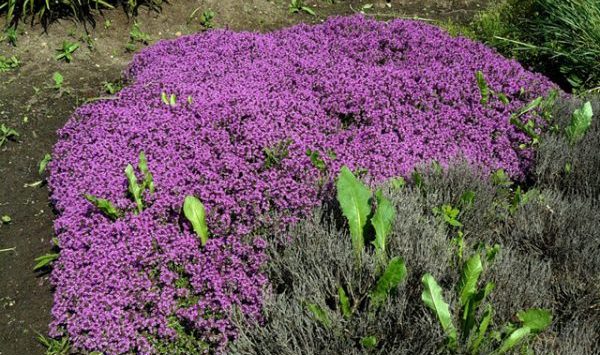Thyme: growing and describing the plant
Content
Landing
For planting thyme, you need loose, fertile and well-drained soil with neutral acidity, which is prepared in the fall. During the autumn digging, organic fertilizers are introduced into the soil: compost, humus. Seeds are planted in the ground at the end of May, when the ground has warmed up well, or through seedlings.
Many housewives want to have a decorative bush on the windowsill and are interested in: how to grow thyme at home? For planting, you will need any container (flower pot), on the bottom of which you need to lay drainage and pour soil mixture. Then the pre-soaked seeds are distributed on the surface, sprinkled with a layer of earth on top, and covered with glass until shoots appear. The optimum temperature for seed germination is considered to be 15-17 ° C, which must be artificially created at home. To grow thyme in a garden or vegetable garden, you should choose sunny open areas, since the concentration of nutrients and esters in the leaves of plants depends on this.
Video "Everything Gardeners Need to Know"
Informational video with useful properties of thyme, as well as data on its cultivation.
Growing and care
Caring for thyme in the garden consists of regular watering, weeding and feeding. Shrubs growing in the garden only need watering and feeding. If the seeds are sown in open ground, then about 2 weeks after germination, the plants need to be thinned out, leaving the largest ones at a distance of 10-15 cm, and the soil should be loosened. In the future, weeding and loosening are carried out at intervals of 1 time / 2 weeks.
Water the thyme often, but make sure that the soil is not too wet - the culture tolerates drought better than excessive moisture. Top dressing is applied several times during the season: in the fall, when digging a site - organic matter, in the spring before planting and before harvesting - mineral mixtures (superphosphate, saltpeter).
Harvesting begins during the flowering period (June-August). Flowering shoots are cut with a sharp knife at a level of 8-10 cm above the soil surface. For the winter, the bushes are cut, spud, and then covered with compost, humus and dry leaves.
Reproduction
Thyme can be propagated in several ways:
- planting seeds directly in the garden;
- through seedlings, which involves sowing seeds in early spring at home in containers or pots;
- dividing the bush;
- by cuttings.
Since thyme seeds germinate in the open field for a long time and poorly, it is best to grow the crop through seedlings. This method allows you to plant already matured young plants in the spring, and avoid unnecessary hassle with sowing in the garden.Experienced gardeners prefer to grow thyme by cutting, or dividing the rhizome. When the bush fades, with sharp scissors you need to cut twigs 10-15 cm long, remove the leaves, then deepen the cuttings with one end into wet sandy soil, and cover with foil.Every day, the soil must be moistened until leaves appear on the branches - this means that the roots have sprouted and the plants can be replanted. There are other ways thyme can be propagated. Creeping varieties tend to strengthen with roots in the soil, and thus multiply independently.
Which varieties to choose
The genus Thyme has about four hundred species, of which about two hundred grow in our latitudes. In the wild, thyme is found in meadows, mountain slopes and rocks, and its cultivated varieties are planted in the garden bed, in the garden, and are also used to decorate the landscape in the country - flowering ground cover varieties look very impressive on alpine hills, cascade beds, and just along stone tracks. Thyme shrubs surprise with their diversity. Depending on the species and variety, the plants differ in the shape and size of the bush (from 15 to 40 cm, creeping thyme has a height of only 5-8 cm), the color of the leaves - from light green with stripes to dark, and even grayish. The multiple inflorescences of white, yellow, different shades of lilac, and also pink, located at the ends of the shoots, give a special decorative effect to the shrubs.
When choosing a thyme variety, you need to consider the purpose of the plants. If the culture will be planted in a garden or on a plot near a house for decorative purposes, then it is better to choose flowering creeping species. If for treatment or eating, then you need to choose aromatic varieties with a high content of essential oils.
In our climate for growing in the country, as well as on the windowsill in the apartment, the following types of thyme are best suited:
- Creeping. It is a low shrub with long creeping shoots. The plant is very unpretentious and frost-resistant, grows well in the wild on sandy soils. Creeping thyme has good decorative properties: it grows quickly, forming a dense carpet on the surface, and blooms very intensively with purple inflorescences throughout the summer. Due to these qualities, creeping thyme is often used by designers to decorate flower beds, lawns, slopes in a rocky garden.
- Ordinary. This type of thyme is the most popular because it has the most pronounced taste and aroma. It is grown primarily for medicinal and culinary purposes. The shrub is quite compact (15-20 cm in height) with slightly spreading branches, which allows it to be planted not only in the country, but also in a pot on the windowsill.
- Citric. Varietal thyme with a pronounced lemon aroma. It is used for cooking and has good medicinal properties. The bush is compact (20-30 cm), the flowers are small, pale lilac. Heat-loving, like all hybrids, does not tolerate frost well.
- Nectar. Vegetable hybrid with slightly creeping, but heavily leafy branches. It has a slightly bitter taste and delicate aroma. Differs in high productivity and cold resistance.
Other varieties of thyme can also be used in landscape design. For example, the decorative variety "Mossy" is distinguished by small intertwining leaves with lilac inflorescences, due to which it forms a thick carpet 1-2 cm high on the soil surface.
Video "How to plant thyme"
Demonstration video with recommendations for planting thyme.





